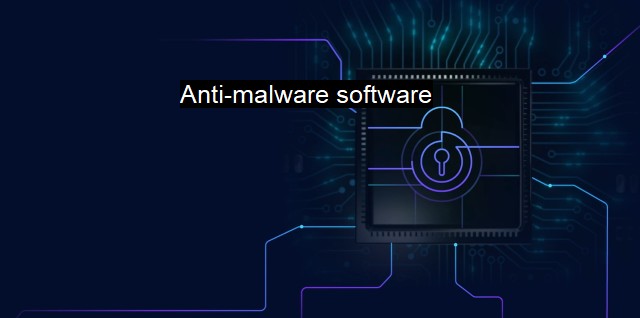What is Anti-malware software?
Securing Your Digital World: Understanding the Basics of Anti-Malware and its Importance in Cybersecurity
Anti-malware software, a vital component of cybersecurity, works to prohibit, identify, and remove malicious software, or malware, threatening the health of computer systems and the confidential information stored therein. The term "malware" encompasses any number of malicious software variants, from ransomware and spyware to viruses, that dishonestly access and damage the system. This major cybersecurity threat warrants utilizing dependable anti-malware software that continuously examines and shields the computer from potentially irreversible harm.Conceived as a protective buffer, anti-malware software guards against malware attacks in real-time, auditing and immunizing a system in one single stroke. Anti-malware software possesses the proactive capacity to scan, quarantine, and eliminate the detected invasive software and files. Various anti-malware software incorporates sophisticated machine learning algorithms to identify potential threats, recognizing patterns associated with known malware and predicting behaviors indicative of malicious intent.
Anti-malware software thrives on its capability to accomplish both preventative and responsive measures through scans. It includes broad scans cataloging the entire system, individual file scans inspecting a particular folder or file, and background scans enabling systematic detection, all while minimizing system disruption or delays. Directing critical attention towards newly downloaded or currently executing programs helps pinpoint potential invasive software before causing irreparable damage.
Other key functions of this software extend to include the creation and protection of system firewalls, execution of internet security protocols, spam email filtering, snake-oil protection, web browsing security, and in some cases Virtual Private Network (VPN) solutions. Anti-malware software is specifically designed to counteract malicious activity by employing a multitude of security features, striving to present an invariably insurmountable feature for any attempted breach.
Viruses, a type of malware, replicate and infuse into another program or file, taking control over systems to harm or halt their operation. Antivirals are a subset of anti-malware software, specifically built to nullify said intrusive viruses. A common confusion arises in distinguishing between antivirus and anti-malware software due to the overlapping of certain characteristics, although both have distinct functions. Antivirus software primarily shields against established threats and less sophisticated encroachments, signifying their proficiency in warding lower-level threats. Anti-malware, in contrast, focuses on broader protection including mathematical detection of newly emerging malicious software, thus proving effective against advanced threats.
Anti-malware software performs frequent updates of malware definitions, recognizing the various changing tactics, techniques, and procedures employed by malicious adversaries to bypass system protections. In exponentially growing online environments prone to threats with every click, resilient anti-malware software proves critical to ensuring a dependable defense structure that protects sensitive data and enhances the system's overall health.
While adopting anti-malware software enhances system security, it should not singularly constitute the entire cybersecurity strategy. A robust defense encompasses multi-layered shielding, necessitating updated software, a reliable backup protocol, education, and secure practices. One should incorporate smart browsing habits, use secure connections, avoid dubious downloads, and maintain vigilance about clicking on unknown links that pose cyber threats.
In the modern era where digital is the way forward, businesses and individuals cannot afford to ignore cybersecurity. The adage 'prevention is better than cure' holds absolute truth in the context of digital defense. Utilizing reliable, updated, and multi-pronged anti-malware software constitutes a crucial step in supporting a safe virtual environment, safeguarding digital assets, and developing a strong comprehension of potential threats. As the human element remains the weakest link implementing best practices, such as using established anti-malware programs, becomes fundamental in hindering the ever-looming presence of cyber threats.

Anti-malware software FAQs
What is anti-malware software and how does it work?
Anti-malware software is a cybersecurity tool that is designed to detect, prevent, and remove malicious software or malware from a computer system. It works by scanning the system for known malware signatures, anomalous patterns, and behavior to identify and protect against potential threats.What types of malware does anti-malware software protect against?
Anti-malware software protects against a wide range of malware, including viruses, trojan horses, worms, spyware, adware, ransomware, and other types of malicious software that can harm your computer or steal your data.Do I need to update my anti-malware software regularly?
Yes, it is essential to update your anti-malware software regularly to ensure that it can detect and protect against the latest malware threats. Cybercriminals are always developing new types of malware, and updating your software ensures that it has the most recent malware definitions to detect and block new threats.Is it necessary to have anti-malware software if I have a strong firewall installed?
Yes, having a strong firewall is an essential part of your computer's security system, but it is not enough to protect against malware threats. Anti-malware software offers an additional layer of protection by scanning and removing any malicious software that may have bypassed your firewall or other security measures.| | A | | | B | | | C | | | D | | | E | | | F | | | G | | | H | | | I | | | J | | | K | | | L | | | M | |
| | N | | | O | | | P | | | Q | | | R | | | S | | | T | | | U | | | V | | | W | | | X | | | Y | | | Z | |
| | 1 | | | 2 | | | 3 | | | 4 | | | 7 | | | 8 | | |||||||